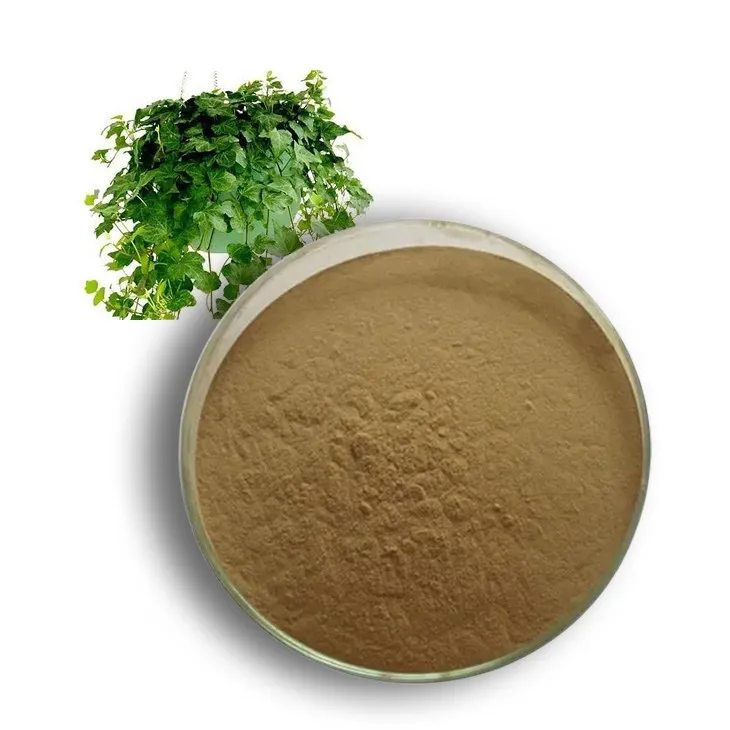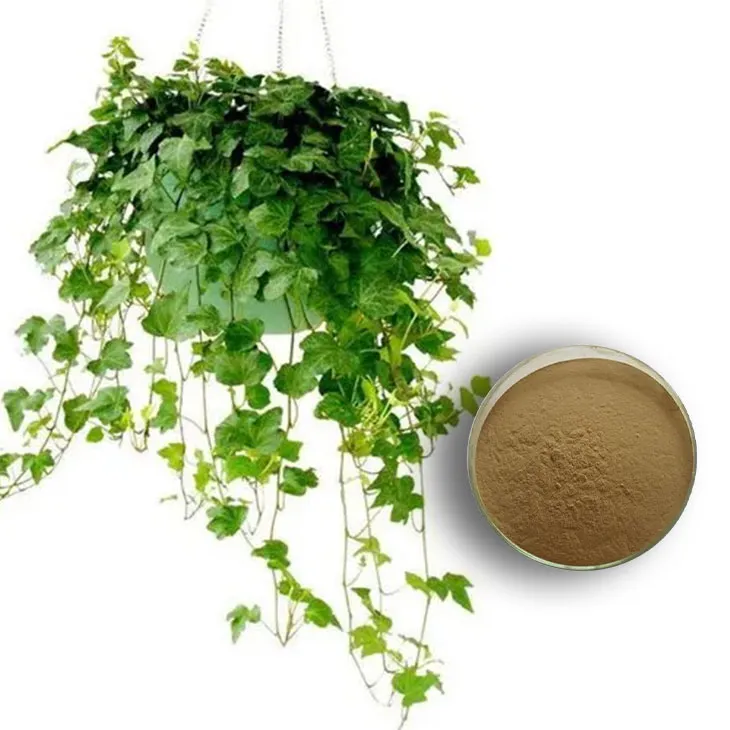- 0086-571-85302990
- sales@greenskybio.com
The best method for extracting ivy extract.
2024-11-29

1. Introduction
Ivy (Hedera spp.) has been widely studied for its potential medicinal properties. Ivy Extracts contain various bioactive compounds such as saponins, flavonoids, and alkaloids, which have shown antioxidant, anti - inflammatory, and antimicrobial activities. Therefore, the extraction of high - quality Ivy Extract is of great significance in the fields of medicine, cosmetics, and food industry.

2. Different extraction techniques
2.1. Solvent extraction
2.1.1. Organic solvents
- One of the most common methods is using organic solvents like ethanol, methanol, and ethyl acetate. Ethanol is often preferred due to its relatively low toxicity, high solubility for many bioactive compounds, and ease of removal. For example, in a typical extraction process, dried ivy leaves are soaked in ethanol at a certain ratio (e.g., 1:5, w/v) for a period of time, usually several hours to days.
- Methanol can also be used, but it is more toxic than ethanol. However, it may have a higher solubility for some specific compounds. Ethyl acetate is another option, especially for the extraction of lipophilic compounds in ivy.
- Water can be used as a solvent for extraction. Aqueous extraction is considered a more "natural" and environmentally friendly method. However, the solubility of some hydrophobic compounds may be limited. To improve the extraction efficiency, some additives like surfactants can be added to the aqueous solution. For instance, a small amount of sodium dodecyl sulfate (SDS) can enhance the extraction of certain bioactive components from ivy.
2.2. Supercritical fluid extraction (SFE)
2.2.1. Principle
- Supercritical fluid extraction uses supercritical fluids, most commonly carbon dioxide (CO₂), as the extraction solvent. CO₂ is in a supercritical state above its critical temperature (31.1 °C) and critical pressure (73.8 bar). In this state, it has properties between those of a gas and a liquid, such as high diffusivity and low viscosity, which enable it to penetrate into the plant material easily and extract the target compounds effectively.
- One of the main advantages is the selectivity of extraction. By adjusting the pressure and temperature, different components can be preferentially extracted. For example, at a certain pressure and temperature combination, it is possible to extract more saponins while minimizing the extraction of unwanted impurities.
- Another advantage is that the supercritical CO₂ is non - toxic, non - flammable, and leaves no residue in the final extract, making it very suitable for applications in the food and pharmaceutical industries.
- It also has a relatively fast extraction rate compared to traditional solvent extraction methods.
- The equipment for supercritical fluid extraction is relatively expensive, which limits its widespread use in small - scale operations. The high pressure required in the process also demands strict safety precautions.
2.3. Microwave - assisted extraction (MAE)
2.3.1. Working mechanism
- Microwave - assisted extraction utilizes microwave energy to heat the solvent and the plant material simultaneously. The microwaves interact with the polar molecules in the system, causing rapid heating. This rapid heating leads to the expansion of plant cells and the release of intracellular components into the solvent more efficiently than traditional extraction methods.
- It significantly reduces the extraction time. For example, a traditional solvent extraction of Ivy Extract may take several hours, while microwave - assisted extraction can complete the process in a matter of minutes to tens of minutes, depending on the power of the microwave and the amount of sample.
- The extraction efficiency is also improved. The rapid heating and internal pressure build - up in the plant cells help to break the cell walls more effectively, allowing better access to the bioactive compounds.
- One drawback is that the microwave energy may cause degradation of some heat - sensitive compounds. Therefore, careful optimization of the extraction parameters such as microwave power and extraction time is required to minimize this effect.

3. Factors affecting extraction efficiency
3.1. Particle size of raw material
- The particle size of ivy leaves or other parts used for extraction has a significant impact on the extraction efficiency. Smaller particle sizes generally result in a larger surface area exposed to the solvent, which promotes better mass transfer. For example, if the ivy leaves are ground into a fine powder instead of using whole leaves, the extraction rate and yield of bioactive compounds are likely to be increased.
- However, if the particle size is too small, it may cause problems such as clogging of the extraction equipment or increased solvent retention, which may affect the purity of the final extract.
3.2. Solvent - to - material ratio
- The ratio of solvent to the ivy material is an important factor. A higher solvent - to - material ratio usually leads to better extraction efficiency, as there is more solvent available to dissolve the target compounds. For example, a ratio of 10:1 (solvent:material) may extract more bioactive compounds compared to a ratio of 5:1.
- However, a very high solvent - to - material ratio may not be cost - effective and may also require more time and energy for solvent removal in the subsequent purification steps.
3.3. Extraction time and temperature
- For solvent extraction methods, both extraction time and temperature play important roles. Longer extraction times generally increase the extraction yield, but there is a limit. After a certain time, the extraction rate may reach a plateau, and further increasing the time may not significantly improve the yield. Moreover, excessive extraction time may lead to the extraction of unwanted impurities.
- Temperature also affects the extraction. Higher temperatures can increase the solubility of the target compounds in the solvent and accelerate the mass transfer process. However, high temperatures may also cause the degradation of some thermally sensitive compounds. For example, in the case of aqueous extraction, if the temperature is too high, some flavonoids in ivy may be oxidized or decomposed.

4. Quality control during the extraction process
4.1. Purity assessment
- One of the key aspects of quality control is to assess the purity of the ivy extract. Various analytical techniques can be used for this purpose. High - performance liquid chromatography (HPLC) is a commonly used method. It can separate and quantify the different components in the extract, allowing the identification of the main bioactive compounds and the detection of any impurities.
- Gas chromatography - mass spectrometry (GC - MS) can also be used, especially for the analysis of volatile components in the extract. By comparing the chromatographic and mass spectrometric profiles of the extract with those of pure standards, the purity of the extract can be determined.
4.2. Bioactivity testing
- Since the bioactive properties of ivy extract are of great importance, bioactivity testing is essential for quality control. In - vitro assays such as antioxidant assays (e.g., DPPH assay, ABTS assay) can be used to evaluate the antioxidant activity of the extract. These assays measure the ability of the extract to scavenge free radicals, which is related to its potential health - promoting effects.
- Anti - inflammatory assays, such as the inhibition of lipopolysaccharide (LPS) - induced nitric oxide (NO) production in macrophages, can also be carried out. If the ivy extract shows significant anti - inflammatory activity in these assays, it indicates that the extraction process has not significantly damaged the bioactive compounds responsible for this activity.
4.3. Standardization
- Standardization of the ivy extract is crucial for ensuring consistent quality. This involves setting specific standards for the content of key bioactive compounds. For example, if saponins are the main bioactive components of interest, a standard can be set to ensure that the extract contains a certain percentage of saponins within a defined range.
- Standardization also helps in comparing the quality of different batches of extracts and in meeting the regulatory requirements of different industries, such as the pharmaceutical and food industries.
5. Conclusion
In conclusion, there are several extraction techniques available for obtaining ivy extract, each with its own advantages and disadvantages. Solvent extraction is a traditional and widely used method, while supercritical fluid extraction and microwave - assisted extraction offer some unique features in terms of selectivity, extraction speed, and product quality. The best method for extracting ivy extract depends on various factors such as the target compounds, the scale of production, cost - effectiveness, and the requirements for product quality. Factors affecting extraction efficiency, including particle size, solvent - to - material ratio, extraction time, and temperature, need to be carefully optimized. Moreover, strict quality control during the extraction process, including purity assessment, bioactivity testing, and standardization, is essential for obtaining high - quality ivy extract.
FAQ:
What are the common extraction techniques for ivy extract?
Some common extraction techniques for ivy extract include solvent extraction, such as using ethanol or methanol as solvents. Another method is supercritical fluid extraction, which often uses carbon dioxide in a supercritical state. Steam distillation can also be used in certain cases, especially when volatile components are of interest.
How do different solvents affect the extraction of ivy extract?
Different solvents have different polarities and solubilities. Ethanol, for example, is a moderately polar solvent that can dissolve a wide range of components in ivy. Methanol, which is more polar, may extract different compounds compared to ethanol. Non - polar solvents may be less effective in extracting polar compounds present in ivy. The choice of solvent depends on the specific compounds in ivy that one wishes to extract.
What factors can influence the extraction efficiency of ivy extract?
Several factors can influence the extraction efficiency. The particle size of the ivy material matters; smaller particles generally provide a larger surface area for extraction, increasing efficiency. Temperature also plays a role. Higher temperatures can often increase the solubility of compounds and the rate of extraction, but excessive heat may also cause degradation of some sensitive components. Extraction time is another factor; longer extraction times may lead to more complete extraction, but may also introduce impurities over time.
Why is quality control important during the extraction of ivy extract?
Quality control is crucial during the extraction of ivy extract. It ensures that the final product is consistent in terms of its chemical composition. This is important for applications such as in the pharmaceutical or cosmetic industries. Quality control helps to detect and remove impurities, ensure the correct concentration of active compounds, and verify the absence of harmful substances. Without proper quality control, the safety and effectiveness of the ivy extract cannot be guaranteed.
How can one determine the quality of ivy extract?
The quality of ivy extract can be determined through various methods. Chemical analysis techniques such as high - performance liquid chromatography (HPLC) can be used to identify and quantify the active compounds present. Spectroscopic methods like infrared spectroscopy can provide information about the functional groups in the extract. Additionally, microbiological testing can be carried out to ensure that the extract is free from harmful microorganisms.
Related literature
- Optimization of Ivy Extract Extraction Process: A Comprehensive Review"
- "Advanced Techniques in Ivy Extract Extraction and Quality Assurance"
- "Solvent Selection in Ivy Extract Extraction: Principles and Practices"
- ▶ Hesperidin
- ▶ Citrus Bioflavonoids
- ▶ Plant Extract
- ▶ lycopene
- ▶ Diosmin
- ▶ Grape seed extract
- ▶ Sea buckthorn Juice Powder
- ▶ Fruit Juice Powder
- ▶ Hops Extract
- ▶ Artichoke Extract
- ▶ Mushroom extract
- ▶ Astaxanthin
- ▶ Green Tea Extract
- ▶ Curcumin
- ▶ Horse Chestnut Extract
- ▶ Other Product
- ▶ Boswellia Serrata Extract
- ▶ Resveratrol
- ▶ Marigold Extract
- ▶ Grape Leaf Extract
- ▶ New Product
- ▶ Aminolevulinic acid
- ▶ Cranberry Extract
- ▶ Red Yeast Rice
- ▶ Red Wine Extract
-
Red Date Extract
2024-11-29
-
Curcumin
2024-11-29
-
Troxerutin
2024-11-29
-
Black Garlic Extract
2024-11-29
-
Cranberry Extract
2024-11-29
-
Green Tea Extract
2024-11-29
-
Alisma Extract
2024-11-29
-
Polygonum multiflorum extract
2024-11-29
-
Eucommia Ulmoides Extract
2024-11-29
-
Motherwort Extract
2024-11-29





















